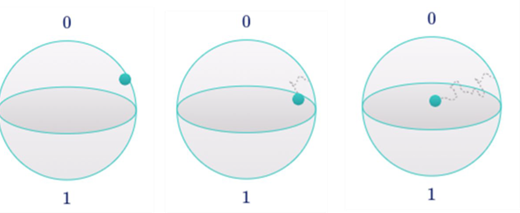The Quantum Leap
February 21, 2024
Welcome to the next installment of the “Quantum Leap Beginner Guides,” aimed at audiences without physics training and using only the most basic math (and even then, only when necessary). So far in this series we have reviewed the general concept of Quantum Mechanics, how quantum mechanics are leveraged via Qubits to take advantage of Wave- Particle Duality, Superposition, and Entanglement, and how the Observer Effect adds additional challenges to quantum applications. I hope these earlier guides enabled readers to get a general sense of how we are now using some of the features of quantum mechanics to perform tasks and calculations never before possible. This introductory series now turns to Coherence, a tricky challenge increasingly being overcome. At the simplest level, coherence refers to a quantum state, such as the position of a Qubit, and the length of time such a Qubit stays in the desired position. Decoherence is the opposite, or the process of a Qubit wandering from its desired position, as depicted in the graphic below:
You’ll note three time-sequenced pictures of a 3-D representation of a Qubit (known as a Bloch sphere) with its globe-like representation of a Qubit with “0” at the north pole, and “1” at the south pole. In this example, the Qubit starts with the blue dot pointing to roughly 2 o’clock. You’ll then note the Qubit “wandering” along the surface of the sphere away from this initial state. The ability for the Qubit to remain in a precise position is fundamental to further usage, but quantum particles (such as Qubits) are extremely sensitive to any and all environmental inputs including gravity, vibrations, electromagnetism, temperature fluctuations and even interference from subatomic particles from outer space. When any of these factors impact the Qubit and it shifts from its desired position, that is referred to as decoherence and its ability to remain in its initial position is coherence.
How is Coherence Measured?
The general concept of coherence is vitally important in Quantum Computing. There are two primary types of coherence: 1) The first measures how long a Qubit can stay at 0 or 1, measuring the time it takes to “flip” to the other state, the equivalent of the classical computing “bit-flip” (more on that below), which is known as a Qubit’s T1 time; and 2) The time a Qubit stays in “phase”, which is known as its T2 time. As you may recall from prior posts, Qubits leverage the properties of quantum mechanics including wave-particle duality, and “phase” references its wave properties. Generally, but not always, T2 times are shorter than T1 times and so T2 is often referenced as the limiting variable of a Qubit.
How Much Coherence is Needed to Leverage Quantum Properties?
While this is a natural question to ask, the answer is a bit fluid. Let’s first review this question in the context of Quantum Computing. To operate a Quantum Computer, a user places the Qubits in an initial state, and then runs through a series of operations or gates, to do things like rotate the Qubits or combine Qubits via entanglement. At the end, the end results are read out – an overall process generally known as a Quantum Algorithm. There are four primary properties that impact the power of a Quantum Algorithm:
The number of Qubits available
The length of time a Qubit remains in coherence (T2)
The fidelity of a 2-Gate sub-process of the Quantum Algorithm
The speed of a given process (usually referred to as Gate Speed)
When I began learning about Quantum Computing, I was fascinated to learn that typical T2 times were extremely short. Consider that the median T2 for IBM’s Heron superconducting Quantum Computer with 133 Qubits is 127.24 millionths of a second. That means that whatever algorithm you may try to run, must complete its process incredibly quickly because after about 127 microseconds, the Qubits will decohere to the point where the output will be meaningless. Neutral atom and trapped ion-based Quantum Computers enjoy longer coherence times, generally measured in full seconds, but their gate speeds are much slower. There are invariably trade-offs in whatever platform is selected.
Dealing with Decoherence
One way to improve coherence is to design and create robust Qubits and Quantum Computers that support exquisite Qubit control including software that optimizes operation (error suppression). The other way is to find the errors that decoherence causes, and correct them (error correction), although this is quite tricky.
When classical computers were being advanced, the main error occurred when a bit flipped from a 0 to a 1 or vice versa (a bit-flip error). Early classical computing error correction would generally take three bits to run each step of code (known as “repetition code”), with each string being either 000 or 111. If some other string were ever encountered, for example 101, the computer would recognize it and use “majority rule” to correct it. So in this example, it would assume the middle bit had been inadvertently flipped and change 101 to 111.
The first problem with bit-flip correction codes on Qubits, is that we can’t measure the Qubit mid-circuit to test it, because that collapses the Qubit (see the Observer Effect post for a
refresher). Because of this, Quantum error correction generally needs 5-9 extra, or ancillary, Qubits to create 1 “logical” Qubit, much like classical computing’s repetition code (although longer). The second problem is that Qubits are 3-dimensional, so not only do they suffer from bit-flip type errors, but they also experience phase errors.
Summary
Dozens of companies now have Quantum Computers available for broad use, and the numbers of Qubits continues to rise (e.g., IBM’s Heron has 133, QuEra’s Aquila has 256, and Atom Computer is on the cusp of a 1,000+ Qubit machine). Others, such as Alice & Bob’s Cat Qubits, are particularly robust agist bit-flip errors. Quantum algorithm designers are also developing sophisticated ways of dealing with decoherence errors with various error correction schemes. We are still in the early stages of QC advancement, but progress is happening very quickly. Controlling individual atoms, electrons or photons is extremely difficult, but possible, and leveraging quantum mechanics stands to provide amazing new capabilities in science and industry. Stay tuned to The Quantum Leap to follow the progress.
References:
Bloch sphere coherence graphics screen-scraped from Q-CTRL’s Black Opal, in the Noise module on February 21, 2024.
Biercuk, Michael J., “Making Quantum Error Correction practical”, Q-CTRL.com, January 12, 2024
Lukin, Alex, and Macri, Tommaso, “Guest Post – Unlocking the Quantum Frontier: Coherence in Neutral Atom Systems,’ The Quantum Insider, October 3, 2023.
Russell, John, “What is a Cat Qubit and Why Should You Care? Ask Alice & Bob”,
HPCWire.com, August 1, 2023.
“Quantum Computing Has Entered the Logical Qubit Era. Why Does That Matter?”
Builtin.com, accessed February 3, 2024.
USC Viterbi School of Engineering, Lecture 20, Viterbi-web.usc.edu, accessed February 17, 2024.
If you enjoyed this post, please visit my website and enter your email to receive future posts and updates:
http://quantumleap.blog
Russ Fein is a venture investor with deep interests in Quantum Computing (QC). For more of his thoughts about QC please visit the link to the left. For more information about his firm, please visit Corporate Fuel. Russ can be reached at russ@quantumleap.blog.






